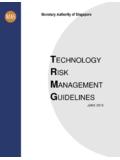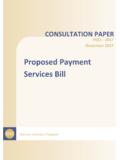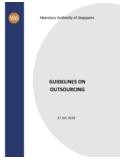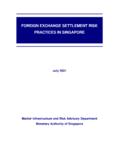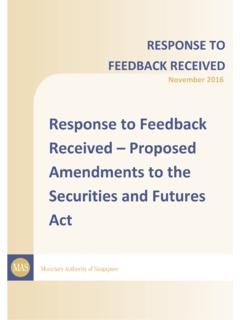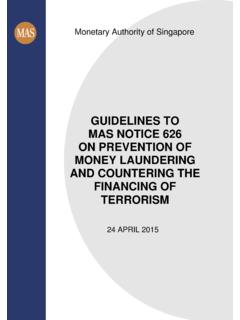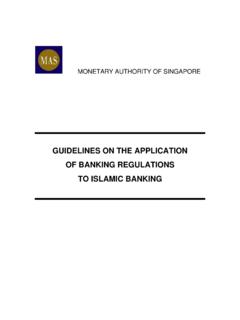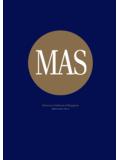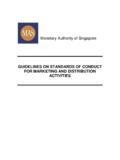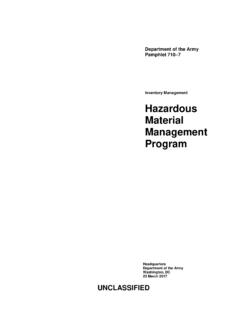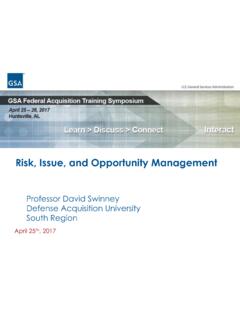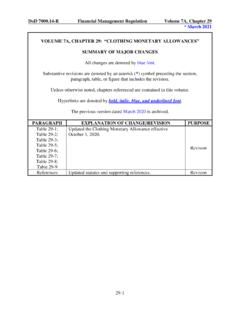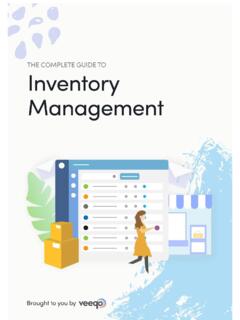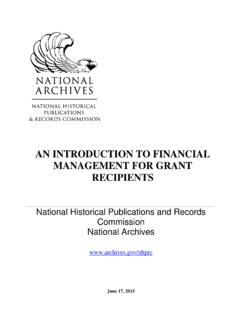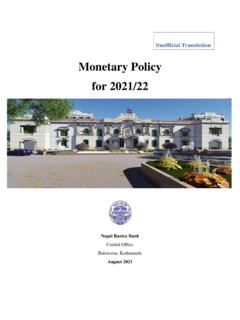Transcription of Monetary Authority of Singapore
1 Monetary Authority of Singapore Monetary Authority of Singapore Monetary Authority of Singapore Monetary Authority of Singapore Monetary Authority of Singapore Monetary Authority of Singapore Monetary Authority of Singapore Monetary Authority of Singapore Monetary Authority of Singapore Monetary Authority of Singapore Monetary Authority of Singapore Monetary Authority of Singapore Monetary Authority of Singapore Monetary Authority of Singapore Monetary Authority of Singapore Monetary Authority of Singapore INTERNAL CONTROLS July 2014 GUIDELINES ON RISK management PRACTICES JULY 2014 - INTERNAL CONTROLS Monetary Authority OF Singapore Table of Contents 1 Introduction 1 Overview 1 Application of Guidelines 1 2 Control Environment 2 Policies and Procedures 2 Code of Conduct 2 Delegation of Authority 3 Segregation of Duties 4 Competency and Resources 4 Audit 5 Compliance 6 Mandatory Leave 8 Handling of Complaints 8 Staff Compensation 9 Recruitment 9
2 Staff Training and Education 9 3 Business Process Controls 10 Dealings with Customers 10 Customer Due Diligence 11 Legal Documentation 12 Accounting and Record Keeping 12 management Information Systems 13 Physical Controls 14 Off-Premises and After Hours Trading 15 New Products/Business Lines/Activities 15 Valuation of Assets 16 Verification and Reconciliation 16 Confirmation 18 Settlement 19 Checklist of Sound Practices to Adopt I GUIDELINES ON RISK management PRACTICES JULY 2014 - INTERNAL CONTROLS Monetary Authority OF Singapore 1 1 INTRODUCTION Overview A system of effective internal controls is fundamental to the safe and sound management of institutions.
3 Effective internal controls help an institution protect and enhance shareholders value and reduce the possibility of unexpected losses or damage to its reputation. Internal controls are the policies, procedures and processes established by the Board of Directors (Board) and senior management to provide reasonable assurance on the safety, effectiveness and efficiency of the institution s operations, the reliability of financial and managerial reporting and compliance with regulatory requirements. Application of Guidelines This chapter provides guidance on sound and prudent internal The guidelines are not intended to be exhaustive nor do they prescribe a uniform set of requirements on internal controls for all institutions.
4 The extent and degree to which an institution adopts these guidelines should be commensurate with the institution s risk and business profile. This chapter is divided into two sections: control environment and business process controls. The first section outlines the key elements of the control environment which set the tone for the control culture of an institution and influence the control consciousness of its staff. The second section focuses on the internal controls in specific areas or activities within an institution. 1 Institutions should also take into account applicable industry standards such as the Basel Committee on Banking Supervision The Internal Audit Function in Banks (June 2012) and Implementation of the Compliance Principles (August 2008), where appropriate, and subsequent or other relevant publications that may be issued from time to time.
5 GUIDELINES ON RISK management PRACTICES JULY 2014 - INTERNAL CONTROLS Monetary Authority OF Singapore 2 2 CONTROL ENVIRONMENT Policies and Procedures An institution should institute adequate internal control systems and reporting to assist its Board, or its delegated Authority , in the fulfilment of its responsibilities for oversight over the institution s risk management framework. The Authority and responsibilities of each control function should be properly documented. The head of each control function should periodically review such document and submit suggestions for any changes to senior management and the Board for approval.
6 An institution should have comprehensive and sound policies approved by the Board for prudent management of significant risks arising from its business activities and operations. The approved policies should be consistent with the nature, complexity and materiality of the institution s activities. There should be a clear delineation of roles, responsibilities and accountability for the implementation of consistent policies across the institution. An institution should establish appropriate procedures and processes to implement its policies. These should be documented in procedural manuals.
7 The manuals should be periodically reviewed to ensure that they reflect current practices. There should also be adequate systems to monitor compliance with established policies and procedures. Deviations from such policies and procedures should be independently investigated, reported and addressed by the relevant parties. Code of Conduct It is in the interest of an institution to conduct its activities with prudence and integrity. In this regard, the institution should establish a code of conduct that is commensurate with its structure and complexity of operations. The code of conduct should state the ethical values of the institution and prescribe guidelines for employees to observe when discharging their duties.
8 The code should cover areas such as acceptance of gifts and entertainment, conflicts of interest, safeguarding of confidentiality of information, and disclosure of and restrictions on personal investments. In addition to general guidelines, an institution should prescribe specific guidelines for operations in functional areas such as investment banking, private banking and treasury. For instance, with regard to treasury and financial derivatives activities, institution should take into consideration the GUIDELINES ON RISK management PRACTICES JULY 2014 - INTERNAL CONTROLS Monetary Authority OF Singapore 3 good market practices outlined in The Singapore Guide to Conduct and Market Practices for Treasury Activities when coming up with specific guidelines for this area.
9 Additionally, there should be independent and close supervision over the conduct of dealers and their relationship with brokers. The institution should monitor the reason for using particular brokers and ensure that trades are only conducted with approved brokers. There should be clear guidelines on the acceptance of entertainment and gifts from brokers. Broker statements should be reviewed by staff independent of the trading function and proper records should be maintained on benefits received from brokers. Unusual trends in benefits or consideration received from brokers should be highlighted. The guidelines should also apply to dealings with customers who have frequent and sizeable transactions with the institution.
10 An institution should have adequate policies, procedures and controls to address conflict of interest situations. It should require employees to disclose such conflicts on a timely basis. These cases should be escalated to either the Board or senior management , and disclosed to customers where relevant. Dealers should not be trading for their personal accounts. An institution should ensure that all personnel understand and adhere to the code of conduct. The code should come under the purview of a senior staff or an appropriate unit. Employees should be required to acknowledge in writing that they have read, understood and will observe the code.
